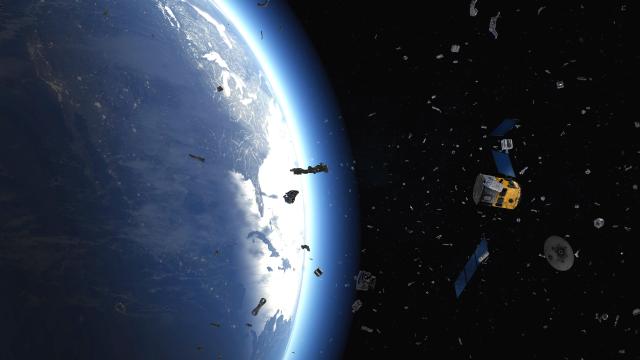Orbital debris from a Russian anti-satellite weapons test is menacing the Starlink satellite constellation, with researchers reporting more than 6,000 close calls with the SpaceX satellites.
The near collisions were discussed during a talk on Monday at the Small Satellite Conference in Utah, SpaceNews first reported. According to Dan Oltrogge, chief scientist at COMSPOC, a company that tracks objects in space, debris from the destruction of Cosmos 1408, a defunct 2,000 kg satellite launched in 1982, is causing an increasing number of close approaches, or what Oltrogge calls “conjunction squalls.”
COMSPOC tracked more than 6,000 close approaches, in which the busted pieces of space junk came to within 10 kilometres of SpaceX Starlink satellites in low Earth orbit. These close approaches threatened 841 Starlink satellites, of which 2,748 are now in orbit.
Last November, Russia destroyed an old satellite with an anti-satellite missile. The test created hundreds of pieces of space debris in the process, forcing astronauts and cosmonauts aboard the International Space Station to seek shelter. About two months later, the debris threatened a Chinese satellite, coming as close as 14.5 metres to the Tsinghua science satellite.
At the time, the test produced at least 1,500 bits of trackable debris that “will likely generate hundreds of thousands of pieces of smaller orbital debris” over time, according to U.S. Space Command. The debris continues to linger and threaten satellites in orbit, especially those in Sun-synchronous orbits (satellites fixed in the same position relative to the Sun). SpaceX recently positioned a group of its satellites in a similar orbit, resulting in the recent close calls with the Russian space debris, according to SpaceNews.
The Starlink satellites are designed to autonomously manoeuvre themselves to avoid collision, an important feature that will help them evade high-speed space junk. But as SpaceNews pointed out, it’s “unclear how many, if any, of the satellites had to manoeuvre to avoid collisions.”
The irony here is that SpaceX itself is increasing the chance of space collisions, sending up a fleet of thousands of satellites into orbit. NASA recently expressed its concerns over the Starlink satellites’ risk of orbital collisions in a letter submitted to the Federal Communications Commission. SpaceX defended itself against the accusations, claiming in a February statement that it’s “committed to maintaining a safe orbital environment.”
Regardless of who is responsible for increasing the risk of collisions in space, it’s clear that something has to be done now to avoid these types of incidents in the future, lest we make portions of Earth orbit completely inaccessible.
